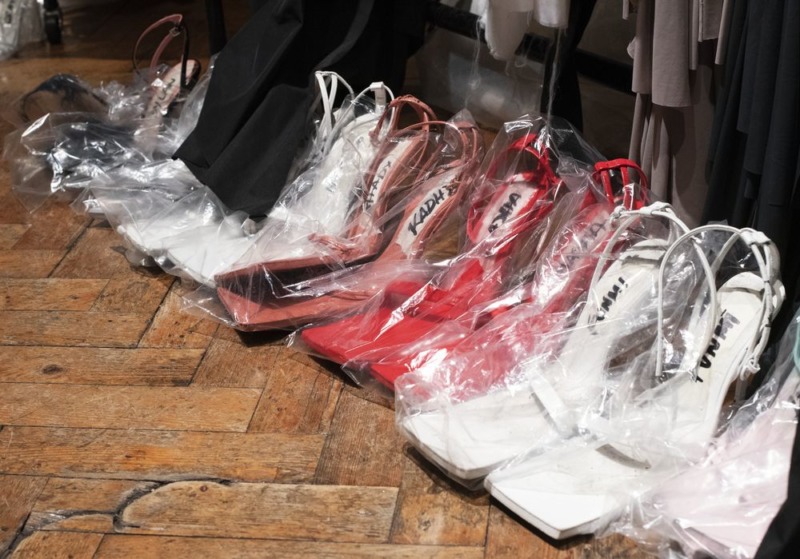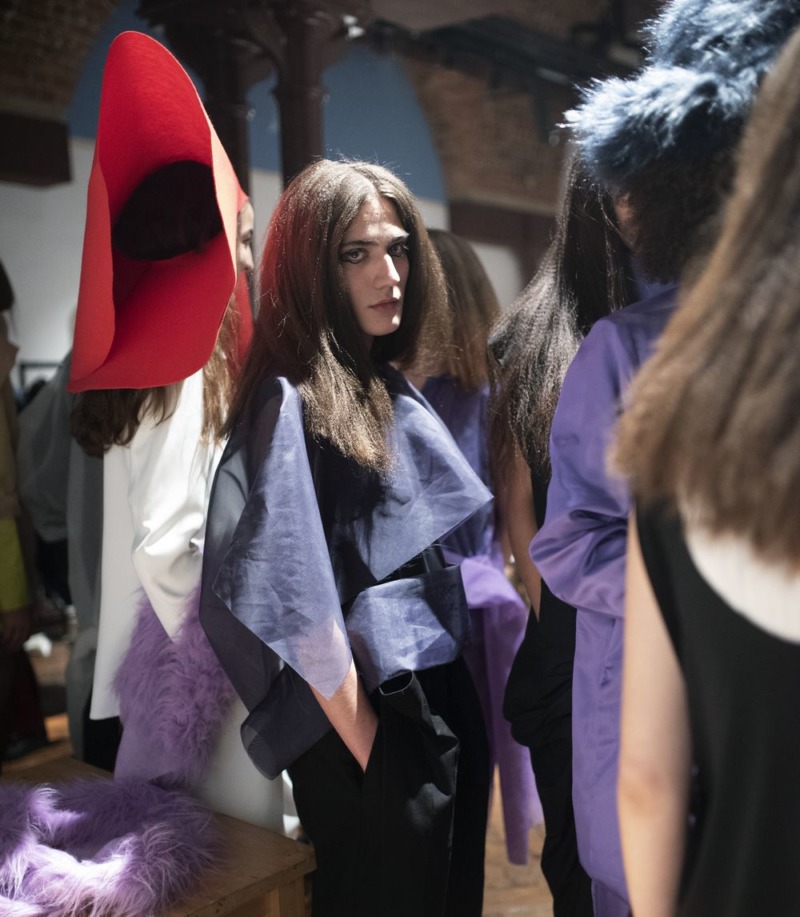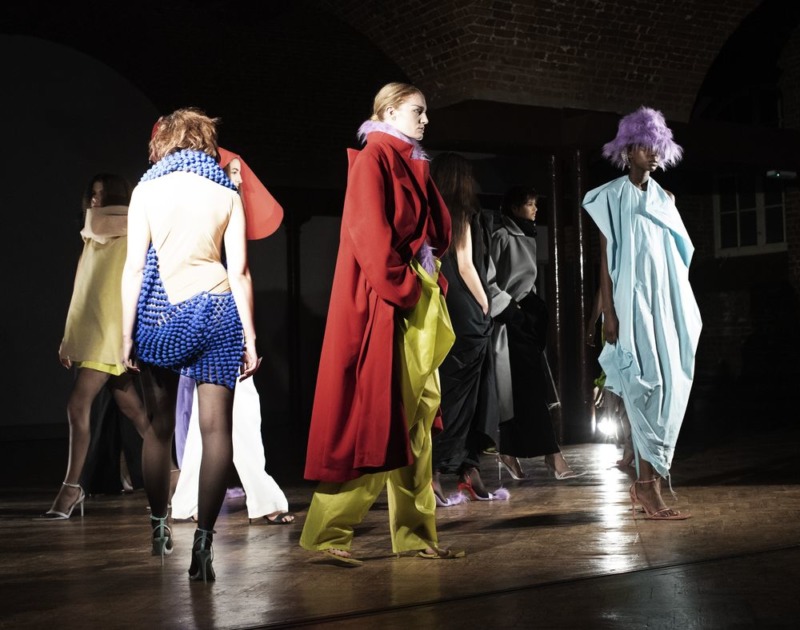LONDON FASHION WEEK AW19 – an interview with Ernesto Naranjo
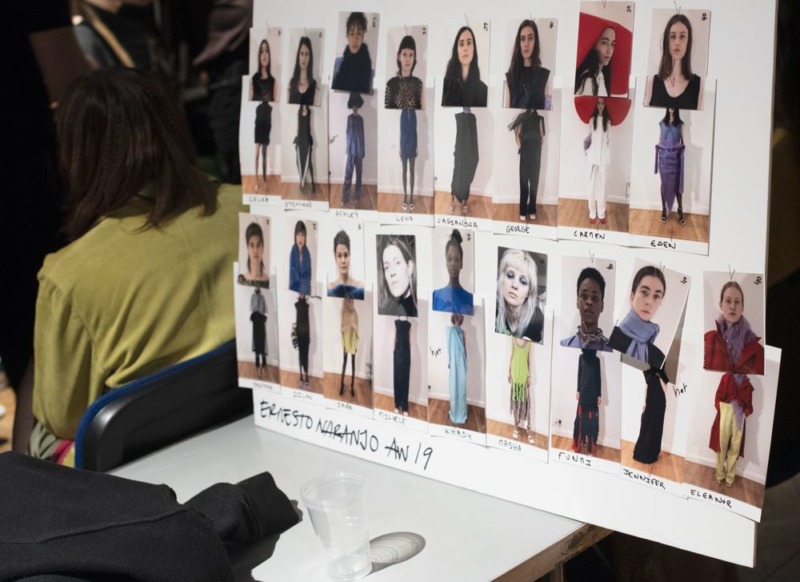
After graduating from Central Saint Martins, the Spanish-born designer Ernesto Naranjo moved to Paris, the “Grande Dame” of Fashion, to pursue his haute couture dreams as part of John Galliano’s team at Maison Margiela and Oliver Rousteing at Balmain.
AW19 marked Naranjo’s return to London. Every red, oversized flap hat, neon green slip dress with knot detailed hems and ultraviolet, furry bucket hats served as a reminder of the designer’s previous work in the haute couture department. While the silhouettes were very reminiscent of his previous work, the materials such as nylon and wool, made the collection fit for the Ready-to-Wear umbrella.
The presentation, a continuation of the designer’s eponymous brand debut at the Palais de Tokyo in Paris last July, is based on the eccentric personalities and works of the surrealist artists Louise Nevelson and Meret Oppenheim. “(Those women) dressed in sharp silhouettes and bold colours – they were just having fun.”, Naranjo explained. AW19 was a direct translation of those female surrealists’ aesthetic and in no way short of beautiful silhouettes and eye-catching colours.
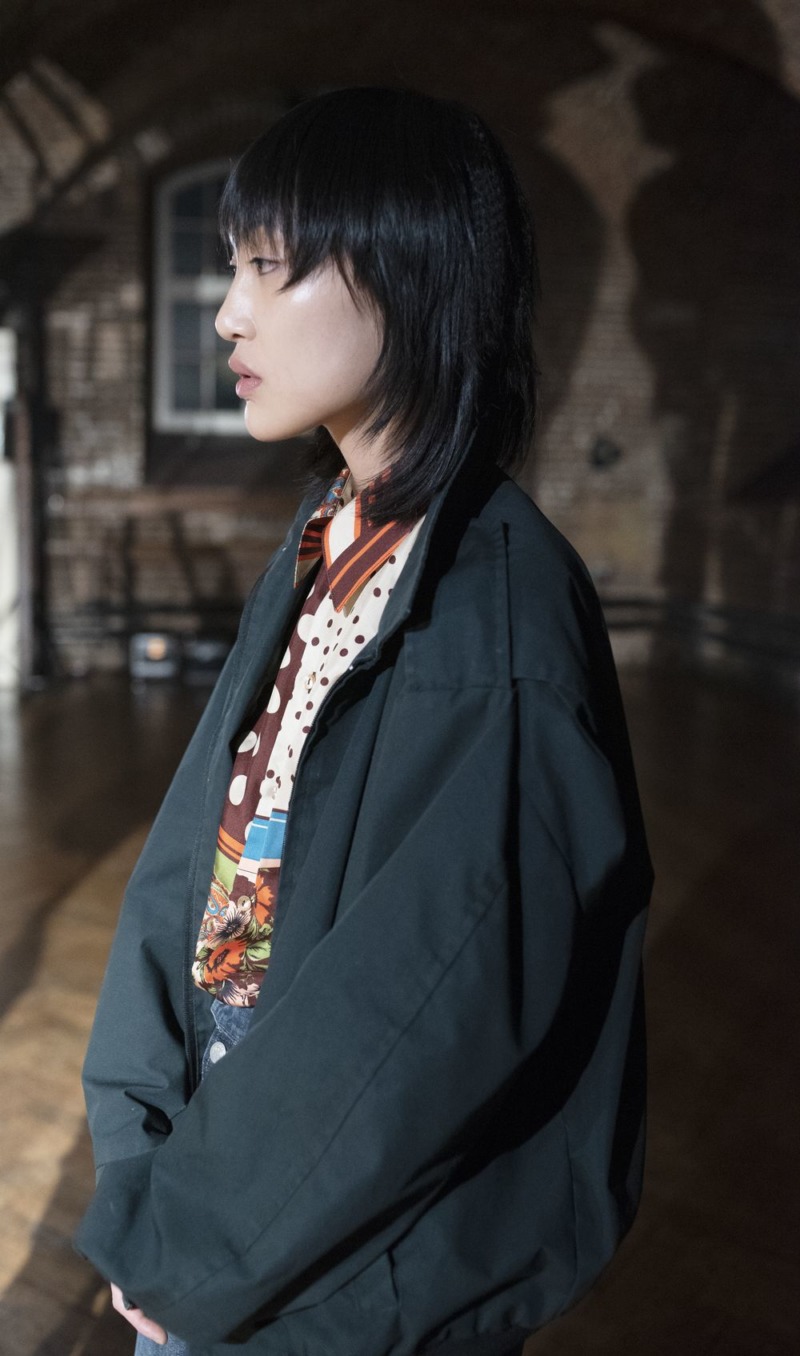
You’ve previously talked about the importance of the women in your family, especially your mom and grandmother. How do your Spanish heritage and the women in your family inform your work?
The women in my family that I’ve always been surrounded by are very strong, yet playful at the same time. I’ve always loved seeing how much fun they had when they dressed up for a special occasion. Listening to the way they talked to each other and the themes of their conversations was another constant source of inspiration. Growing up, they have been the main support system of the family, so when I’m talking of my Spanish heritage, I’m usually talking of them. When you grow up with women like that, it’s going to stay in your mind forever. As a designer, it seems natural to me that I use those memories as a point of reference. It’s somehow ironic if you think about it though – they live in a small village in the south of Spain. Fashion is not even on people’s radar over there and still, the women create such incredible looks without knowing anything about trends, colours or even references.
Before deciding to pursue fashion design as a career, you named architecture as your first choice of career. How does this passion for construction and appreciation for beautiful buildings translate into your designs?
I’ve always been interested in shapes and the construction side of things. My dad sparked that interest in me – he works on a construction field so he always explained to me the process of building houses and all the things, big and small, that you need to join together in order to create a proper house. It’s like a big puzzle where everything has to fit perfectly and every detail is important. I think that fashion has those same qualities, except that it’s more related to feelings and experiences. My designs always start with a basic geometric shape that is moulded around a woman’s body. Even though geometry and movement can be seen as unrelated in the first place, I always try to find common ground and fuse them together in my collections – it’s like a marriage, just between geometry and movement.
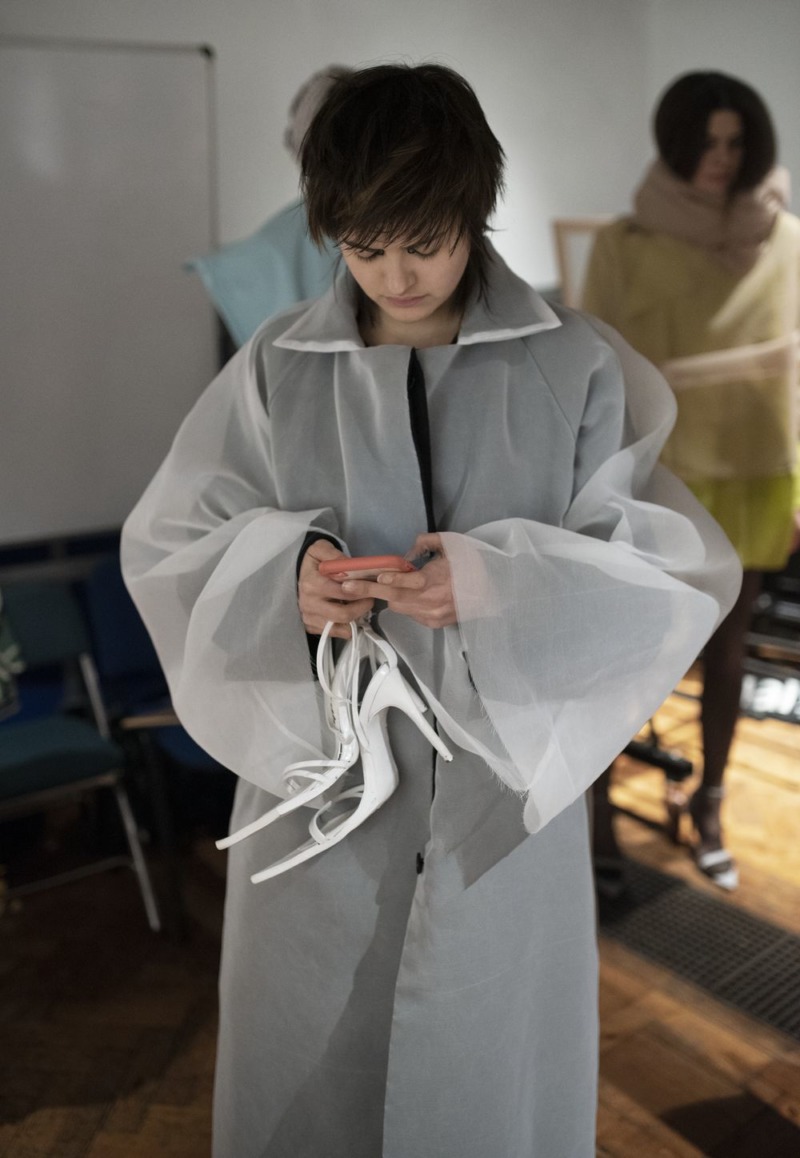
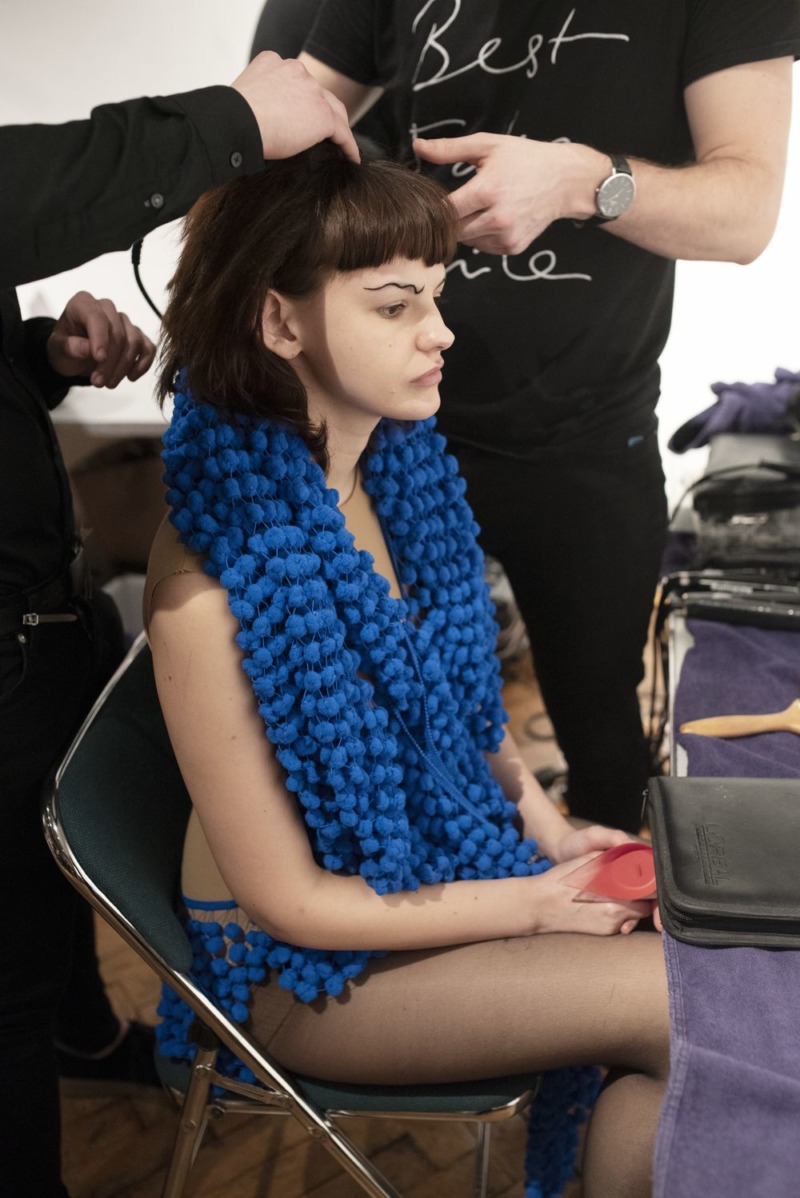
You’ve called the collaboration project that you did with your friend Paula Canovas Del Vas for the ‘season-less, life performance brand’ PHVLO a ‘great learning curve’. Could you elaborate on that idea for us?
Working with another creative mind is always an amazing journey and a great learning curve at the same time. You have to find a way to connect through discussions, the exchange of ideas and references. After that initial connection, you have to find a common way to create something beautiful.
Paula is also Spanish. We grew up in similar settings and were surrounded by similar aesthetics so we have many common references that go back to our childhood. The collaboration that we did for PHVLO was the starting point of a collaborative duo that will hopefully be continued soon.
You’ve previously mentioned that you’re very methodical, yet authentic when it comes to your work. What does your research process look like in relation to this?
The starting point of my research process is always visual. I select loads of images that I talk about with my mother and grandmother to get their input and understand the way they see those images. I think it’s important to sometimes get another, external point of view on the same subject. After this initial stage, I start working in 3D – I make collages, mix colours and organise fittings on real models. I always try not to be too hermetic about the final result – you can create something, but you have to let it free for everyone to see and interpret afterwards.
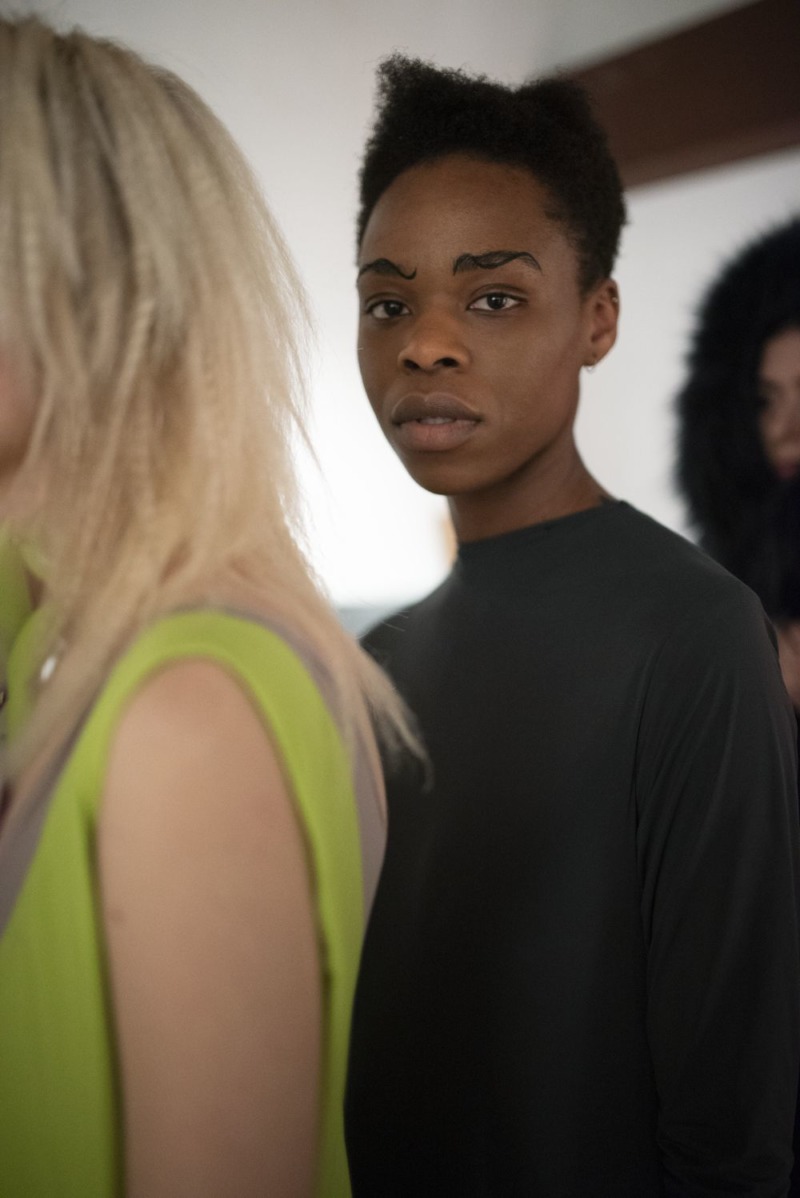
After your graduation, you’ve worked for Maison Margiela and Balmain. How have those fashion houses influenced the work you do now as a designer?
Working for John Galliano at Maison Margiela has really changed how I see fashion and how I transform my creativity into a reality. John is such a great person. He gave me the possibility to work beside him and experience the creative process behind both the Artisanal and the Ready-to-Wear collection. Another thing he taught me is to just stick to your own identity and preferences instead of blindly following trends. Those work experiences helped me to understand how fashion houses work and what steps I needed to take to build a brand.
You’ve both experienced working as a designer in London and Paris. How do these two fashion metropoles compare?
I think the biggest difference is that Paris is where the business happens while London is packed with creative minds. Paris is more classical and has a certain feeling of maturity to it, while London is all about that free and fearless vibe. Personally, I’d always choose London over Paris because it’s where I learned everything I know about fashion – it’s also where my fashion family is.
What would you consider to be the biggest challenge for a young creative like yourself when setting up a business in London?
London is over-saturated with young designers which can be a disadvantage when you’re starting off. You have to find a way to be different, to communicate through your clothes and find your place in the industry. London is great for young talents but talent needs to be guided in a professional way, so I’d say that one of the biggest challenges would definitely be to become more mature and professional while standing out.
With ‘Objets trouvés’, you celebrated your debut in the Palais de Tokyo in Paris last July. What can we expect from your AW19 collection?
My AW19 collection is a translation of the collection that I showed in Paris. It’s based on two surrealist artists, Meret Oppenheim and Louise Nevelson. They dressed in sharp silhouettes and bold colours – they were just having fun and didn’t care if a piece of accessory didn’t sit properly with the rest of the look. My collection is a translation of that. You’ll see a mix of geometric shapes and strong colours that are reminiscent of the strong and powerful identities of these women.
What’s next for Ernesto Naranjo?
Keep on working on developing a signature and a voice through my work. Keep on dreaming and designing for women of all ages!
All clothes Ernesto Naranjo AW19. All images © Stephie Devred

